Why Do I Have Ceiling Damage After My Roof Replacement?
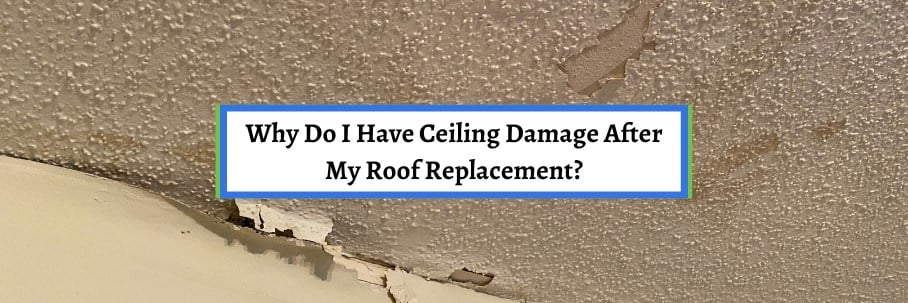
Why do you have ceiling damage after your roof replacement?
If you have ceiling damage after your roof replacement, it most likely means you have a leak from improper installation. If a leak isn't the cause, it’ll be something else more extreme, like stepping through the ceiling.
Well, you replaced your roof to avoid this happening. That’s why seeing a wet spot or full-on water damage on your ceiling is so shocking.
After spending thousands on a new roof, this is the last thing you expect. So, why do you have ceiling damage after a roof replacement?
For over 30 years, the team at Bill Ragan Roofing has taken pride in educating homeowners on both the good and the bad of the roofing industry. That’s why I’ll help you understand why you have ceiling damage after getting a new roof and what to do about it.
This article answers the following questions:
- Why do you have ceiling damage after your roof replacement?
- Is the roofing contractor responsible for ceiling damage after your roof replacement?
- How do you know if you got a bad roof replacement?
Why do you have ceiling damage after your roof replacement?
If you have ceiling damage after your roof replacement, it most likely means you have a leak. For a leak to happen right after a replacement means your roof was improperly installed.
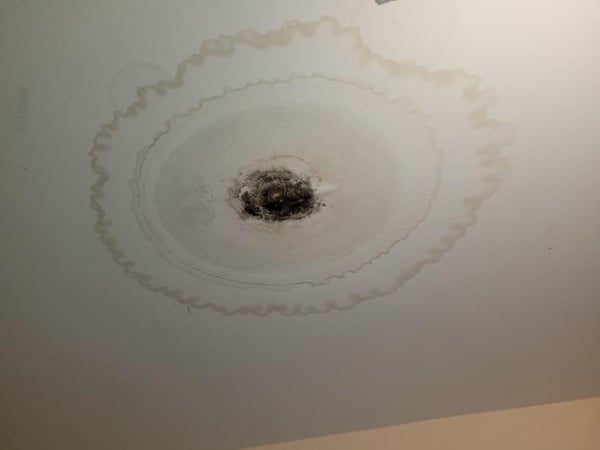
This could be from the roofing contractor being lazy, using shortcuts to cut down on time and cost, or not caring about doing a good job. If you looked for the cheapest roof replacement possible, this is more likely.
However, improper installation doesn’t necessarily mean a roofing contractor did anything malicious. But if a roofing contractor followed proper installation instructions and gave it the attention to detail it needs, your new roof shouldn’t have problems.
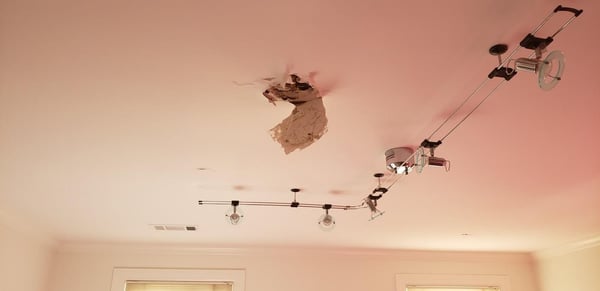
If a leak doesn’t cause ceiling damage after a roof replacement, it’ll be something else extreme, like stepping through the ceiling in the attic. However, you would definitely notice this before they even left your property.
Is the roofing contractor responsible for ceiling damage after your roof replacement?
If your new roof is leaking from improper installation, it’ll be covered by your roofing contractor’s workmanship warranty. This means the roofing contractor should take care of the issues at no charge to you.
Taking care of the leak is important, but a reputable roofing contractor will also pay for the ceiling damage. However, it ultimately depends on the contract you signed.
While the leak should be covered no matter what, they don’t have to do anything about the ceiling if the signed contract says they’re not responsible for inside damage. Unfortunately, bad roofers always hide things like this in the contract’s fine print.
But as long as you hired a reputable roofer, they should take care of the ceiling damage you're experiencing, plus the roof leak causing it.
How do you know if you got a bad roof replacement?
By now, you know that improper installation is probably the cause of your ceiling damage after your roof replacement. Unfortunately, you probably won’t recognize when you got a bad roof replacement until it’s too late.
While a new roof leaking is a huge sign of poor workmanship, there are other ways to determine that you got a bad roof replacement.
Your roof doesn’t have a uniform appearance
If your roof doesn’t have a uniform appearance, you most likely have a bad roof replacement. You’ll notice lifted shingles, bumps, or a wavy look that makes the roof look uneven.
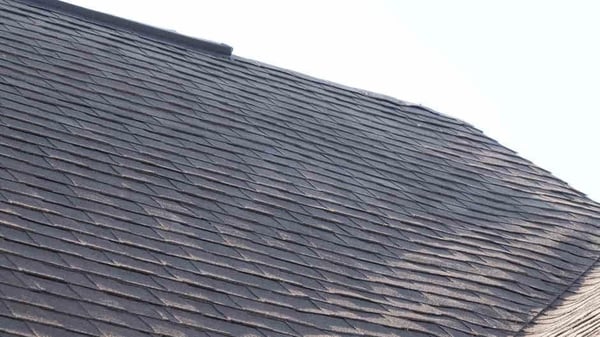
Like all installation problems, this is caused by improperly driven nails, cutting corners, or lazy workmanship. But like when a new roof leaks, a reputable roofing contractor will take care of the problem.
If you don’t think the aesthetic issue is a big deal, just know you’ll have roof leaks down the road caused by the same things that give your roof an uneven look.
Roofing components were left off during your roof replacement
A roof is a combination of different materials and components that come together to form a complete roof system. Failure to install the proper roofing materials and components during your roof replacement is a huge sign of a bad roof replacement.
The main materials and components that should be replaced during a roof replacement are:
- Roof decking
- Roof flashing
- Underlayment
- Drip edge
- Ice and water shield
- The roofing material you choose
- Ridge capping
- Roof vents
- Pipe boots
The main reason materials or components are left off is to lower prices to win your business. If a contractor ever does this, run the other way because you’re signing up for a bad roof replacement with plenty of leaks in the future.
This makes going over your estimate line-by-line with your roofing contractor crucial to ensure everything your roof needs is included in your replacement.
Compromised roof decking wasn’t replaced before installation
Your roof’s decking is the wooden foundation for your entire roof system. Every piece of compromised decking must be replaced before installing your new roof.
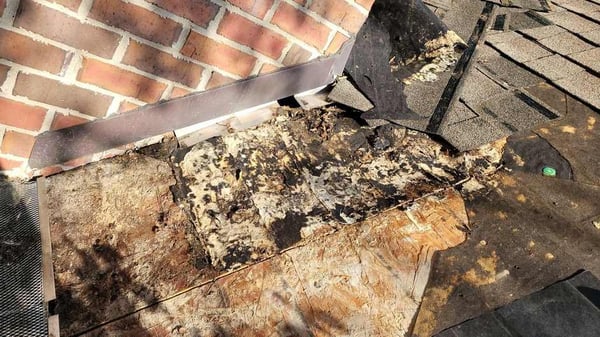 (Rotten roof decking)
(Rotten roof decking)
If a roofing contractor ignores compromised decking, they’re laying the foundation for a bad roof replacement. You’ll see sagging in certain spots because the decking can’t handle the weight of the new materials.
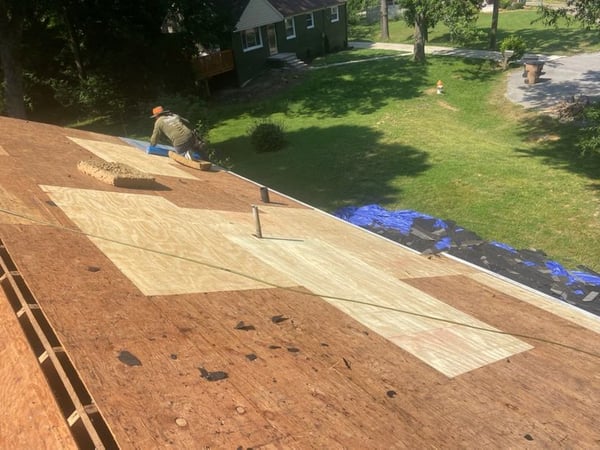 (Sections where decking was replaced before installation)
(Sections where decking was replaced before installation)
There’s also a health issue for your family if rotten boards are left to mildew and mold. Unfortunately, you won’t truly know how much decking needs to be replaced until your old roof is torn off.
Your attic isn’t ventilated properly
After improper installation, inadequate attic ventilation is the main cause of premature roof failure. Without a properly ventilated attic, the trapped hot and cold air shortens your roof’s lifespan.
If your attic wasn’t properly ventilated during your roof replacement, you definitely have a bad roof replacement. During hotter months, the trapped air causes the adhesives in the decking to deteriorate and the shingles to crack or curl.
During cold weather months, trapped cold air mixes with heat and moisture from the interior of your home, causing condensation. This condensation causes your decking to swell and gives your roof a wavy look.
Whether it’s trapped hot or cold air, your roof investment will be ruined without proper attic ventilation.
What recourse do you have for a bad roof replacement?
Now you know the signs that you got a bad roof replacement. Just know that it’s hard to identify most of the signs without a trained eye.
However, you’ll definitely notice a poorly installed roof just by looking at an uneven or bumpy appearance. Once you spot it, immediately contact the roofing contractor and utilize their workmanship warranty.
Unfortunately, a workmanship warranty is only as good as the paper it’s written on. There’s actually a good chance they won’t stand behind a bad roof replacement because they know it wasn’t done right the first time.
But if this happens, just know that there are options available to help you. So, don’t throw in the towel just yet.
Check out What Recourse Do I Have for a Bad Roofing Job to learn your options to remedy a bad roof replacement.


